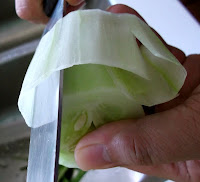When it
comes to matters of food and cooking, everyone knows how the Peranakan
matriarch -- or “Bibik” as she’s called -- can be as touchy and
ultra-territorial as a bull in mating season. Her recipe, she imperiously
declares to all and sundry, is “the most authentic” (and everyone else’s is not
worth a SH*T!)
It’s
funny that every Peranakan household I’ve eaten at (and I’ve eaten at quite a
few in my time) always makes that claim. Therefore if every family’s “version”
of a particular dish is the “correct, authentic, and ONLY one”…. You get the picture?
Whatever
the case may be, there’s no denying that most older Peranakans – female and
male – are superb, passionate cooks. And for any food lover, the Peranakan
kitchen is true paradise; just don’t EVER step on the culinary toes of a Bibik!
My own
exposure to Peranankan cuisine came late in life; but it was near-instant love.
With its heady mix of Malay, Chinese -- particularly Hokkien -- and even
Western influence, how could an adventurous, liberal glutton like myself resist
that food? In fact, every dish I tasted reminded me of something I ate from
another cuisine in Singapore.
And I
realized a few other things: that every home’s “version” of a dish varied from
other homes, in style, ingredient and taste. And that there were a few standard
or “must-have” dishes for formal Peranakan meals. Over the years, I’ve managed
to “steal” recipes and cooking tips from some of the Peranakans I’ve known --
matriarchs, chefs, and so-called “authorities” on the culture. And this
pilfered information has served me well in the kitchen.
This
particular Nonya dish, for instance, is very similar to Fried Hokkien Prawn
Noodles, except that it uses an additional key ingredient in the paste --
taucheo. The garnishing is also far more elaborate.
Nonya Fried Noodle
Prawns 200 g, boiled, then
peeled and set aside the prawn heads and shells
Water 2 cups
Pork
belly 200 g
Squid 150 g
Chinese
sausage 1, steamed for 10 mins and
cut into strips
Oil/lard 3 tbsp
Yellow
flat noodle 400 g, washed and drained
Garlic 1 tsp, minced
Bean
sprouts 100 g
Salt 1½ tsp
Sugar 1 tsp
Light
soy sauce 1 tsp
Dark
soy sauce ½ tbsp
Paste:
Preserved
beans 1 tbsp, mashed
Garlic 1 clove, minced
Cucumber 1, cut into thin strips
Egg 1, fried into
omelette and cut into thin strips
Red
chillies 2, large and cut
into thin strips
Fried
shallots 1 tbsp
Fried
garlic 1 tbsp
Fried
lard crisps 1 tbsp
Pepper to taste
Method:
- Saute preserved bean paste, garlic and prawn
shells for 3 minutes. Add water, pork belly and simmer for 30 minutes.
Meanwhile, add squid and cook until it turns pink. Remove and set aside.
- Remove pork belly and set aside till it
cools. Cut squid and pork belly into thin strips.
- Drain the prawn broth and set aside for
later.
- Boil the prawn broth and season with salt
and sugar.
- In a clean wok, fry noodle and minced garlic
for 3 minutes under high flame. Add stock and simmer for 2 minutes.
- Add prawns, pork belly, squid and Chinese
sausage and continue to simmer for another 1 minute.
- Add bean sprouts and season with both light
and dark soy sauce.
- Serve it on a plate and top with all the
garnishing.








